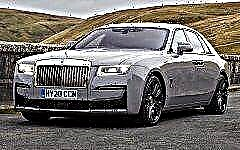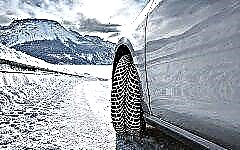

The content of the article:
- "Mechanics" classic
- Automatic transmission
- Robot
- Variable speed drive
It is not known for certain where the term "tinsmith's day" first came from, but it characterizes the state of the first ice on highways in the best possible way. And we are not even talking about summer tires, which not all car owners manage to change. And about a fundamentally different driving style, the functioning of the car and the behavior of various transmissions, which is significantly different from driving in warm seasons.
"Mechanics" classic

Although the popularity of this type of transmission is gradually declining, giving all its laurels to the variator, automatic or robotic transmissions, it is the most reliable for winter travel. It is not for nothing that it is mechanics that are still used in cars intended for rally races, since only it allows the driver to feel the car as much as possible.
The driver himself, without electronic assistants, determines the axle load, dosages traction, and varies the speed for varying complexity of turns.
Professional race car drivers and ordinary drivers with many years of experience bravely operate on ice with both gas and brake pedals, braking without the likelihood of wheel locking.
The first reaction of an inexperienced driver in the face of a dangerous situation is to press the brake. But on ice, such an action can have fatal consequences, as it will lead to an uncontrolled skid. You just need to carefully release the gas pedal and, without touching the brake pedal, wait for the car to slow down gradually.
Another scenario is to downshift and brake with short, hard brakes to avoid locking the wheels. It is according to this principle that the anti-lock braking system (ABS) is triggered, in the absence of which the driver can independently "simulate" it in the above way.
When the car is stuck on the road, the worst action is to add gas. This will lead to the fact that the car stalls even more and will not be able to move. If there is no one nearby who will be able to push the car a little, you should try to get out of the way yourself.
In practice, it looks like this: add a little gas, smoothly but not completely release the clutch, hold it, release it again, leading to the car rocking. In this situation, it is important not to overdo it so that the wheels do not slip again.
The disadvantage of a manual transmission can be called an uphill climb, since it takes a lot of experience to overcome a slope of any height on an icy road. If an uphill route cannot be avoided, then more gas will need to be added than during a normal trip. Gears should be switched at sufficient speed, which must have a certain margin, since, climbing uphill, the car will rapidly lose the gained speed.
Descending the mountain should be in the engaged gear so that the car does not gain uncontrolled speed, and the driver has the opportunity to react if necessary to maneuver or brake.
Automatic transmission

Automatic driving is much easier and more enjoyable. It even has a special winter mode, denoted by a snowflake on a special button, thanks to which the engine is limited in speed, stops at the 3rd stage and is held under the thrust. Such a unit is possessed, for example, by the Japanese Nissan Terrano, facilitating easy overcoming of snow drifts and engine braking at traffic lights or cornering.
Paradoxically, the more expensive 6-speed transmissions found on some Kia and Volkswagen models lack this useful feature. Their selector has a specific groove, labeled "+" and "-". This is a kind of manual automatic transmission mode, which allows the driver to independently vary the steps depending on the road situation. The algorithm of actions is similar to "mechanics" - careful braking with pads with a gradual decrease in speed.
The problem of using automatic transmissions should include the need for regular application of the brake due to ineffective engine braking. When the Drive mode is activated, the transmission reacts in a completely different way from the mechanics to the throttle release. Therefore, you have to apply a gradual reduction in gears or use a semi-automatic mode, which is especially important for cornering, when it is dangerous to lose momentum and traction.
It is possible to brake with the engine if there is a sufficient distance to neighboring cars on the road, since the speed of such braking on the “automatic” will be several times lower than on the “mechanics”, blaming the “syndrome” of torque converter slippage.
In addition, on slippery roads, slowing down can cause the drive wheels to slip and the axles to skid. In this case, on a front-wheel drive car, you should continue to press the gas pedal, on a rear-wheel drive - release, and on an all-wheel drive - first release, but immediately press gently.
Before starting a trip, engineers recommend alternately switching the lever to all positions, accelerating the heating of the transmission fluid with these simple "exercises".
Robotic transmission

In recent years, so-called "robots" of two types can be found more and more often in cars:
- Traditional "mechanics", supplemented by actuators that control the clutch and drive. Such a box has a special control unit that collects and sends information about the traffic situation to the car. This option is budgetary, but unreliable, since the gear changes are extremely slow, as a result of which the car can lose traction and "float" on ice.
- The preselective dual-clutch robot belongs to the higher price category and shows excellent working speed. With really fast gear changes, the wheels never lose traction, and the Sport mode keeps the engine in good shape, turning over 3 thousand rpm. The disadvantages of this transmission include the increased sensitivity of the block of mechanisms to overloads from working in a traffic jam.
Variable speed drive

The Continuously Variable Transmission or CVT function resembles an automatic transmission, although technically its operation looks a little different. It provides a smooth movement of the car, without jerks and with no gear shifting procedure.
Controlling such a transmission is as easy as controlling an automatic one, since they have similar modes and the gear lever itself. It has a variator and a manual gearshift mode, although the steps here look very arbitrary, in the form of fixing specific gear ratios.
This feature has one incomparable advantage - the ability to brake the engine.
Otherwise, the algorithms of actions and the driving pattern are similar to the "automatic", where the main points are the warming up of the transmission and avoidance of slipping. There is only one difference worth mentioning as it makes the CVT more functional on snowy or icy roads.
Since the gear ratio in this box changes very gradually, the connection of the engine to the wheels is not interrupted, which leads to no slip problem. The main thing for the driver is not to supply too much gas, since the variator will cope with all the problems on its own.
Of course, summer road trips are technically much easier, safer, and simply more enjoyable. Precipitation in the form of freezing rain and snow, ice, a mixture of chemicals, salt, road mud can make any trip, a standard road situation unpredictable and dangerous. In an attempt to minimize their risks, motorists buy high-quality winter tires, friction with Velcro or regular studded tires. And they also start the alarm clocks early in order to warm up the engine well, and fill it with the winter oil recommended by the manufacturer.
However, all these measures will not be enough if you do not know how to properly handle the transmission installed in your car. In addition, for a relatively prosperous 8-month warm period, drivers simply get out of the habit of winter extreme and relax on the road.
Therefore, do not hesitate to consult with friends-drivers or read thematic forums, preparing yourself in advance for winter driving.











